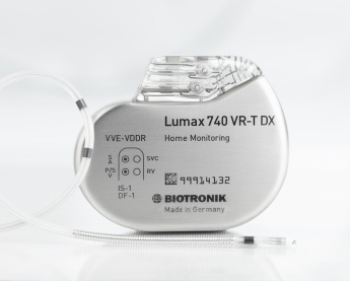BIOTRONIK, a leading manufacturer of cardiovascular medical technology, announced the Food and Drug Administration (FDA) has granted final approval for the BIOTRONIK Lumax 740 DX System. This novel device is a first-in-class implantable cardiac defibrillator (ICD) that utilizes a single lead with atrial sensing capabilities.
 BIOTRONIK's Lumax DX System is a first-in-class implantable cardiac defibrillator (ICD) that utilizes a single lead with atrial sensing capabilities. (Photo: Business Wire)
BIOTRONIK's Lumax DX System is a first-in-class implantable cardiac defibrillator (ICD) that utilizes a single lead with atrial sensing capabilities. (Photo: Business Wire)
Single-chamber ICDs are sophisticated electronic devices that utilize a thin flexible wire, known as a lead, to deliver an electrical shock to the heart when the heart rate becomes dangerously fast. For patients who have, or are at risk of developing atrial fibrillation (AF), a physician may consider implanting a dual-chamber ICD, which utilizes two leads and has pacemaker functions built in. For the more than 70,0002 patients in the U.S. who receive an ICD each year, device selection remains controversial.
“Until now, our only option to obtain important and useful atrial signal information from patients undergoing defibrillator implantation has been to implant a separate atrial lead. Implanting multiple leads in the heart has been shown to increase the risk of complications,2 and the use of dual-chamber devices in patients without a clear indication for the additional atrial lead has received a great deal of attention in recent months. Until now, my approach for patients who do not require atrial pacing has been to implant single-chamber ICDs,” said Bradley P. Knight, M.D., Medical Director, Center for Heart Rhythm Disorders at Northwestern Memorial Hospital’s Bluhm Cardiovascular Institute. “The DX System addresses a significant gap in ICD therapy. Patients now have access to the benefits of both dual and single-chamber ICDs without the risk of additional hardware.”
Traditional standard single-chamber ICDs come with limitations. The devices are designed only to sense changes in ventricular rhythm and are unable to sense atrial arrhythmias, such as AF, correctly. This can result in an increased risk of an inappropriate shock3 or a stroke4 if AF is not detected.
The DX System expands the diagnostic capabilities of a standard single-chamber ICD with a single lead, in addition to featuring sophisticated sensors that allow for atrial monitoring and enhanced arrhythmia diagnosis. The system utilizes the Linoxsmart S DX lead. Based on proven technology, the Linoxsmart S DX utilizes an innovative floating atrial dipole. This allows physicians, for the first-time in an ICD, to capture atrial sensing capabilities with one lead. When combined with the Lumax 740 VR-T DX device—which has optimized circuitry—the system provides a reliable atrial signal. Additionally, its SMART Detection® algorithms discriminate supraventricular tachycardias (SVTs), AF and atrial flutter to reduce the risk of inappropriate shocks.
“Electrophysiologists have long searched for effective diagnostics and disease management capability with a less invasive treatment. But the increased regulatory and financial obstacles associated with bringing innovative technology to market was a challenge,” said Thomas Ahern, M.D., Director of Cardiac Electrophysiology Research at Scripps Clinic. “BIOTRONIK’s commitment to nearly a decade of research for this system has provided electrophysiologists with technology that will allow for better management of cardiac rhythm care for our patients.”
“The DX System is designed with the patient in mind,” said Paul Woodstock, Executive Vice President of Sales and Marketing at BIOTRONIK, Inc., USA. “Expanding on the benefits of single-chamber ICDs, the DX System provides physicians with atrial sensing and home monitoring capabilities to monitor for important atrial conditions such as AF. We believe the system has the potential to be appropriate for more than 50,000, or 71 percent, of U.S. patients who receive an ICD.5”
The DX System also integrates with BIOTRONIK Home Monitoring®, allowing physicians to remotely follow their DX patients’ clinical and device statuses daily—at anytime, anywhere in the world. The cellular-based system has demonstrated the ability to detect clinically relevant events, including silent, asymptomatic arrhythmias,6 and device related issues,7 allowing for earlier medical intervention. The diagnostic capabilities of the DX System combined with Home Monitoring® makes this a simple, yet sophisticated system for cardiac rhythm management.
The DX System is now approved and currently available in most international markets (e.g. E.U., Japan). BIOTRONIK expects to begin U.S. implants in late February/early March.
1 Biotronik data on file
2 Dewland, TA. Dual-chamber implantable cardioverter-defibrillator selection is associated with increased complication rates and mortality among patients enrolled in the NCDR implantable cardioverter-defibrillator registry. J Am Coll Cardiol.. 2011 Aug 30;58(10):1007-13. doi: 10.1016/j.jacc.2011.04.039.
3 Daubert, JP. Et al; Inappropriate implantable cardioverter-defibrillator shocks in MADIT II, JACC 2008; 51: 1357-6.
4 National Stroke Association. Controllable Risk Factors – Atrial Fibrillation. 2013. http://www.stroke.org/site/PageServer?pagename=afib
5 Biotronik data on file
6 Varma N, Epstein AE, Irimpen A, Schweikert R, Love C, for the TRUST investigators. Efficacy and safety of automatic remote monitoring for implantable cardioverter-defibrillator follow-up: The Lumos-T safely reduces routine office device follow-up (TRUST) Trial. Circulation. 2010;122:325-332
7 Varma N, Michalski J, Epstein AE, Schweikert R. Automatic remote monitoring of implantable cardioverter-defibrillator lead and generator performance: The Lumos-T safely reduces routine office device follow-up (TRUST) Trial. Circulation Arrhythmia and Electrophysiology. 2010;3:428-436